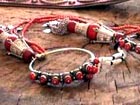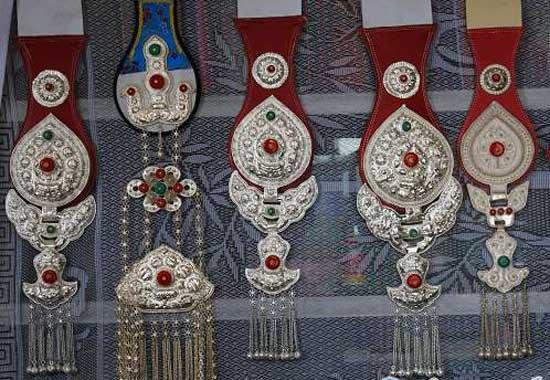| Videos | • Latest |
|
• Feature | • Sports | • Your Videos |
Traditional Tibetan jewelry under threat

 0 Comment(s)
0 Comment(s) Print
Print E-mail CNTV, February 7, 2012
E-mail CNTV, February 7, 2012
Ornamentation has always been extremely important for the Tibetan people. And when it comes to self-adornment, silver is king. Tibetan people believe that wearing silver protects them from bad spirits and can even help in cure disease.
 |
|
Ornamentation has always been extremely important for the Tibetan people. And when it comes to self-adornment, silver is king. |
However, silversmiths in Tibet are under threat from jewellers making items using machines - but the local people are still proud to wear a symbol of their heritage.
Man Ta and her daughter, Zhuo Ma, are proud to wear their silver and do so even while performing simple daily routines such as preparing food.
Man Ta was 17 years old when her mother gave her these adornments. They consisted of necklaces, earrings, belts, and different head ornaments. She feels proud wearing them.
Man Ta said, "We are very proud of our culture. We think that our clothing and jewelry are the best, the most beautiful. So we wear this in order to tell people, 'I am a Tibetan', that we are proud of our culture. "
But those who make the silver pieces the traditional way are becoming increasingly scarce. Dorje Zhu is among the few of them working in the northern region of Sichuan Province, in southwestern China. The 37 year-old studied the art of working silver from one of the few elders who still practiced it. Now, he claims to be the only silversmith left in Shang Si Zhai valley and the nearby Jiuzhaigou area.
Dorje Zhu, silversmith, said, "There used to be a silversmith master before, but now he passed away. He used to be my teacher. I learned the skills from him. And I went to Qinghai to stay there for a while and learn from the people who make the silver. So in Jiuzhaigou, right now, I am the only one that is able to craftsman the silver in the traditional way."
It takes Dorje about three hours to make a ring, but more elaborate designs for belts, for example, can take weeks. He uses metal that he buys in the city, an alloy of copper with a very low component of silver that is stronger than pure silver.
Dorje explains that the content of silver used to be higher decades ago, but the advent of industrialization and the mass production of jewelry has devalued it.
Dorje Zhu said, "There were some outsiders that came bringing the machines to make the same work that we do manually. They can make nicer products than the ones made by hand. Also, handwork is slow, while the machines can work much faster."
Jiuzhaigou National park has become one of China's most popular travel destinations. Around two million visitors come here every year to have a glimpse of the impressive landscapes. But when the park closes, it's time for souvenir shopping.
Dorje warns that many of the pieces sold as souvenirs come from big factories. And some of the jewellery is so cheap its silver content is questionable. There are also places to find the real, hand-carved silver ornaments.
In this restaurant in Jiuzhaigou village, necklaces with strings of precious beads, and pieces of engraved silver are for sale at prices starting at 800 yuan. The price tag might be higher but trader's say it reflects the long hours spent working the silver by craftsmen like Dorje.
It may well be the price of keeping tradition alive.






Go to Forum >>0 Comment(s)